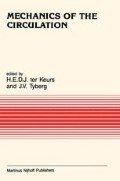Abstract
This symposium focuses on the mechanics of heart muscle contraction, ventricular pump function, and central hemodynamics. Therefore, despite the title, this chapter confines itself to discussions on the mechanical interactions between the heart and the vasculature with special reference to physiological optimizations of their coupling. Such basic knowledge on the interactions is prerequisite for quantitative understanding of the neural and humoral controls of the circulatory system. Take arterial baroreceptor reflex control of ventricular contractility for example. It has repeatedly been observed that reduction of pressure in the isolated baroreceptor does not significantly increase cardiac output even though there is an obvious reflex pressor response. This apparent lack in cardiac response may only be apparent because the reflex augmentation of the contractility may be just enough to overcome the reflex-induced increase in peripheral resistance and hence to maintain cardiac output [1]. Only when the basic mechanics of the interaction between the ventricle and the arterial system are clearly understood, can the true reflex effect on, cardiac contractility be appreciated from the measured change in cardiac output.
Access this chapter
Tax calculation will be finalised at checkout
Purchases are for personal use only
Preview
Unable to display preview. Download preview PDF.
References
Sagawa, K.: Baroreflex control of systemic arterial pressure and vascular bed. In: Handbook of Physiology: The Cardiovascular System III, Am. Physiol. Soc; Washington, D.C., p 453–496, 1984.
Alexander, J., Jr. and Sagawa, K.: Insensitivity of the left atrial end-systolic pressure-volume relationship line to loading conditions. Circulation 68: III—372,1983.
Alexander, J., Jr.: Instantaneous pressure-volume relationship of the impedance loaded canine left atrium: A. Ph.D. thesis submitted to The Johns Hopkins University, 1986.
Coutteney, M.M., De Clerck, N.M., Goethals, M.A., Brutsaert, D.L.: Relaxation property of mammalian atrial muscle. Circ. Res. 48: 352–356,1981.
Brutsaert, D.L., Rademakers, F.E., Sys, S.U.: Triple control of relaxation: implications in cardiac disease. (Editorial) Circulation 69: 190–196,1984.
Guyton, A.C.: Venous return. In Handbook of Physiology, Section 2, Volume 2, Ed. by W.F. Hamilton, Washington, D.C.; American Physiological Society, p 1099–1133,1963.
Shoukas, A. A. and Sagawa, K.: Control of total systemic vascular capacity by the carotid sinus baroreflex. Circ. Res. 33: 22–23,1973.
Shoukas, A.A.: Carotid sinus baroreceptor reflex control and epinephrine influence on capaci-tive and resistive properties of total pulmonary vascular bed of the dog. Circ. Res. 51: 95–101, 1982.
Levy, M.N.: The cardiac and vascular factors that determine systemic blood flow. Circ. Res. 44: 739–746,1979.
Sylvester, J., Gilbert, J.R., Traystman, R., Permutt, S.: Effect of hypoxia on the closing pressure of the canine systemic arterial circulation. Circ. Res. 49: 980–987,1981.
Brunner, M.I., Greene, A.S., Sagawa, K. and Shoukas, A.A.: Determinants of systemic zero-flow arterial pressure. Am. J. Physiol. 245: H453-H460,1983.
Sunagawa, K., Sagawa, K. and Maughan, W.L.: Ventricular interactions with the loading system. Ann. Biomed. Eng. 12: 163–189,1984.
Yamashiro, S.M., et al.: Optimal control analysis of left ventricular ejection. In: Cardiovascular System Dynamics, Baan, J., Noordergraaf, A., Raines, J. (eds) Cambridge: MIT Press, p 427–431, 1978.
Kenner, T. and Pfeiffer, K.P.: Studies on the optimal matching between heart and arterial system. In: Cardiac Dynamics, Baan, J., Arntzenius, A.C., Yellin, E.L. (eds) Boston; Martinus Nijhoff, 1980, p 261–270.
Milnor, W.R.: Aortic wavelength as a determinant of the relation between heart rate and body size in mammals. Am. J. Physiol. 237: R3-R6,1979.
Van der Horn, G.N., Westerhof, N. and Elzinga, G.: Optimal power generation by the left ventricle: A study in the anesthetized open thorax cat. Circ. Res. 56: 252–261,1985.
Piene, H., Sund, T.: Does normal pulmonary impedance constitute the optimum load for the right ventricle? Am. J. Physiol. 242: H154–H160,1982.
Sunagawa, K., Maughan, W.L. and Sagawa, K.: Optimal arterial resistance for the maximal stroke work studied in isolated canine left ventricle. Circ. Res. 56: 586–595,1985.
Hunter, W.C.: Analysis of the net pulsatile effect of load on cardiac output. Proc. 35th Ann. Conf. Eng. Med. Biol., p 59,1982.
Elzinga, G. and Westerhof, N.: Pump function of the feline left heart: Changes with heart rate and its bearing on the energy balance. Cardiovasc. Res. 14: 81–92,1980.
Burkhoff, D. and Sagawa, K.: Ventricular efficiency predicted by an analytical model. Am. J. Physiol. 250: R1021–R1027,1986.
Suga, H., et al.: Effect of positive inotropic agents on the relation between oxygen consumption and systolic pressure-volume area in canine left ventricle. Circ. Res. 53: 306–381,1983.
Burkhoff, D., Yue, D.T., Oikawa, R.Y., Franz, M.R., Schaeffer, J. and Sagawa, K.: Influence of contractility on ventricular oxygen consumption. Circulation 72: III–298,1985.
Suga, H., Igarashi, Y., Yamada, O. and Goto, Y.: Mechanical efficiency of the left ventricle as a function of preload, afterload, and contractility. Heart and Vessels 1: 3–8,1986.
Editor information
Rights and permissions
Copyright information
© 1987 Martinus Nijhoff Publishers, Dordrecht
About this chapter
Cite this chapter
Sagawa, K., Sunagawa, K., Burkhoff, D., Alexander, J. (1987). Control of the circulation. In: Ter Keurs, H.E.D.J., Tyberg, J.V. (eds) Mechanics of the Circulation. Developments in Cardiovascular Medicine, vol 69. Springer, Dordrecht. https://doi.org/10.1007/978-94-009-3311-8_23
Download citation
DOI: https://doi.org/10.1007/978-94-009-3311-8_23
Publisher Name: Springer, Dordrecht
Print ISBN: 978-94-010-7986-0
Online ISBN: 978-94-009-3311-8
eBook Packages: Springer Book Archive

